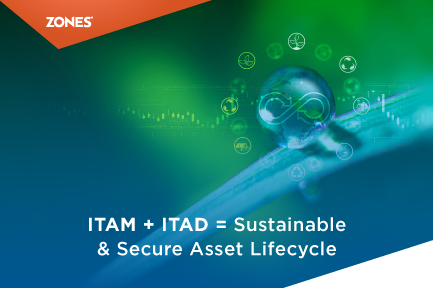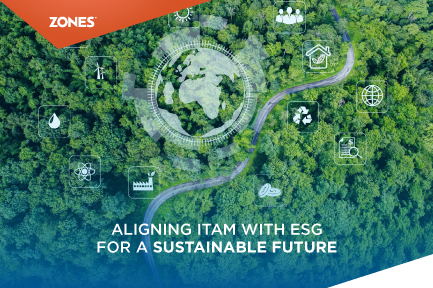IT Asset Disposition (ITAD) & Cybersecurity: Safeguarding Your Data in the Digital Age
Data security has never been as important as before, especially in the modern world, which instantly turns to the online sphere to solve most...
4 min read
George Ganas : Apr 14, 2025 8:06:06 AM

Today, businesses face dual pressures to maximize technology investments while navigating complex security regulations and environmental responsibilities. Two critical operational disciplines—IT Asset Management (ITAM) and IT Asset Disposition (ITAD), when strategically combined, create a comprehensive framework for managing technology throughout its complete lifecycle. This unified approach strengthens security protocols and advances corporate sustainability goals.
In the past, businesses treated ITAM and ITAD as different operations without coordination between the two practices. ITAM primarily served inventory control and license compliance functions, while ITAD was often considered the end-of-life process for disposing of outdated equipment. This disconnected approach has proven insufficient for today's challenges.
The current regulatory landscape requires end-to-end asset tracking, from purchase to decommissioning. Laws such as the General Data Protection Regulation (GDPR), the California Consumer Privacy Act (CCPA), and sector-specific requirements have increased data protection standards, making proper disposal as critical as initial deployment. Also, the commitment toward sustainability and environmental regulations emphasizes responsible end-of-life practices for technology assets.
This intersection of data protection requirements and sustainability imperatives now requires a comprehensive strategy where ITAM and ITAD function as interconnected elements within a unified asset lifecycle management framework.
|
Must Read Top 10 IT Asset Management (ITAM) Trends for 2025 and Beyond |
Data security incidents involving improperly handled decommissioned IT assets continue to create significant corporate risk. According to IBM's most recent Cost of Data Breach Report, organizations now face average breach costs approaching $4.9 million. Integrating ITAM-ITAD addresses these vulnerabilities by implementing:
Maintaining complete, uninterrupted records of the asset lifecycle, right from asset acquisition through final disposition, helps in creating essential audit trails for compliance verification and incident investigation.
Implement rigorous data sanitization processes that are aligned with standards like NIST 800-88 and validated through certified ITAD partnerships.
Establish systems that adhere to evolving international and regional data protection requirements through meticulous asset tracking and disposition documentation.
Environmental responsibility has evolved from an optional initiative to a business necessity. The Global E-waste Monitor reports that electronic waste represents the fastest-growing waste stream worldwide, with only 22.3% being formally collected and recycled. Organizations increasingly face accountability for their environmental impact through ESG reporting requirements and stakeholder expectations.
An integrated ITAM and ITAD approach provides the following benefits:
Complete monitoring and maintenance protocols enabled by integrated asset lifecycle extend equipment utility, reducing unnecessary replacements and associated carbon emissions.
Effective asset management identifies internal reuse opportunities, while established ITAD partnerships facilitate external refurbishment when in-house redeployment isn't feasible.
When technology truly reaches end-of-life, structured ITAD processes ensure materials are recovered through environmentally responsible methods, minimizing landfill impact and reclaiming valuable resources.
Studies from the Green Electronics Council indicate that extending device lifecycles through improved durability and repair can reduce their environmental footprint by at least 5%. Moreover, organizations implementing integrated ITAM-ITAD programs typically achieve significantly higher asset recovery values compared to those without structured approaches.
|
Must Read Top 10 IT Asset Management (ITAM) Trends for 2025 and Beyond |
Developing a unified ITAM-ITAD approach requires systematic planning and organizational adaptation. Essential components of successful implementation include:
Develop comprehensive policies addressing both security and sustainability requirements across all stages: procurement, deployment, management, and retirement. This integration requires standardized workflows that preserve the chain of custody and data integrity throughout the entire asset lifecycle. Clear documentation of these processes is essential for both compliance and operational continuity.
Create multidisciplinary teams, including IT, security, sustainability, finance, and compliance teams. This ensures that all organizational priorities are reflected in asset management policies and procedures. Ensure regular collaboration between these teams to identify optimization opportunities and emerging challenges before they become critical issues.
Deploy unified asset management systems providing visibility throughout the entire lifecycle. Contemporary solutions incorporate features like automated discovery, relationship mapping, and retirement tracking, enabling seamless transitions between lifecycle phases. These platforms should provide dashboard visibility for both security metrics and sustainability outcomes.
Establish thorough evaluation frameworks for ITAD partners, prioritizing security certifications (including NAID AAA, R2v3, e-Stewards), documented chain of custody procedures, and transparent environmental practices. The most effective partnerships include shared metrics for both security outcomes and sustainability impacts, with regular performance reviews.
Establish key performance indicators for measuring both security and sustainability metrics, such as:
Develop ongoing education programs for all stakeholders involved in the asset lifecycle. This ensures a consistent understanding of both security requirements and sustainability objectives. Training should address regulatory compliance, proper handling procedures, and environmental impact awareness to create a culture that values both security and sustainability.
Design processes that prioritize reuse, refurbishment, and recycling pathways for retired assets. This approach maximizes both security (through proper chain of custody and data sanitization) and sustainability (through extended helpful life and adequate materials recovery). Circular economy principles should be incorporated from initial procurement until final disposition.
|
Must Read |
The strategic integration of ITAM and ITAD represents more than operational efficiency—it constitutes a fundamental requirement for organizations committed to comprehensive security and meaningful sustainability. By eliminating traditional divisions between these functions, businesses create holistic approaches that protect sensitive information while minimizing environmental impact.
As regulatory requirements continue evolving and stakeholder expectations regarding environmental stewardship increase, this unified approach becomes increasingly valuable. Organizations establishing integrated programs now will secure competitive advantages through enhanced security positioning, improved sustainability credentials, and optimized returns on technology investments.
Join Zones at the upcoming IAITAM ACE Event in Las Vegas, NV, where I will be presenting a comprehensive session on "ITAM & ITAD: A Unified Approach Towards Security & Sustainability." The presentation will dive deeper into implementation strategies and emerging best practices to help your organization maximize both security and sustainability outcomes through integrated asset lifecycle management.
Q: What immediate benefits can businesses expect when integrating ITAM and ITAD?
A: Businesses typically see enhanced security compliance, fewer data breaches from decommissioned assets, improved asset utilization rates, and increased financial recovery values from retired equipment.
Q: How does this integration impact IT budgeting?
A: Integrating ITAM and ITAD can provide better visibility into the total cost of ownership for technology assets, ensuring accurate forecasting, extending useful lifecycles, and potentially increasing recovery values at disposition.
Q: What's the first step for organizations with separate ITAM and ITAD processes?
A: Conduct a gap analysis between current processes, identify communication breakdowns between acquisition and disposition teams, and establish cross-functional stakeholder engagement.
To learn more about integrating your ITAM and ITAD practices, contact our experts.
-%26-Cybersecurity-Blog-Image.png)
Data security has never been as important as before, especially in the modern world, which instantly turns to the online sphere to solve most...

Today, organizations face increasing pressure to balance operational efficiency with environmental responsibility. Due to this, two key areas have...
-Trends-for-2025-and-Beyond-Blog-Image.png)
The importance of effective IT Asset Management (ITAM) has become increasingly valuable and operationally critical. According to the Enterprise...